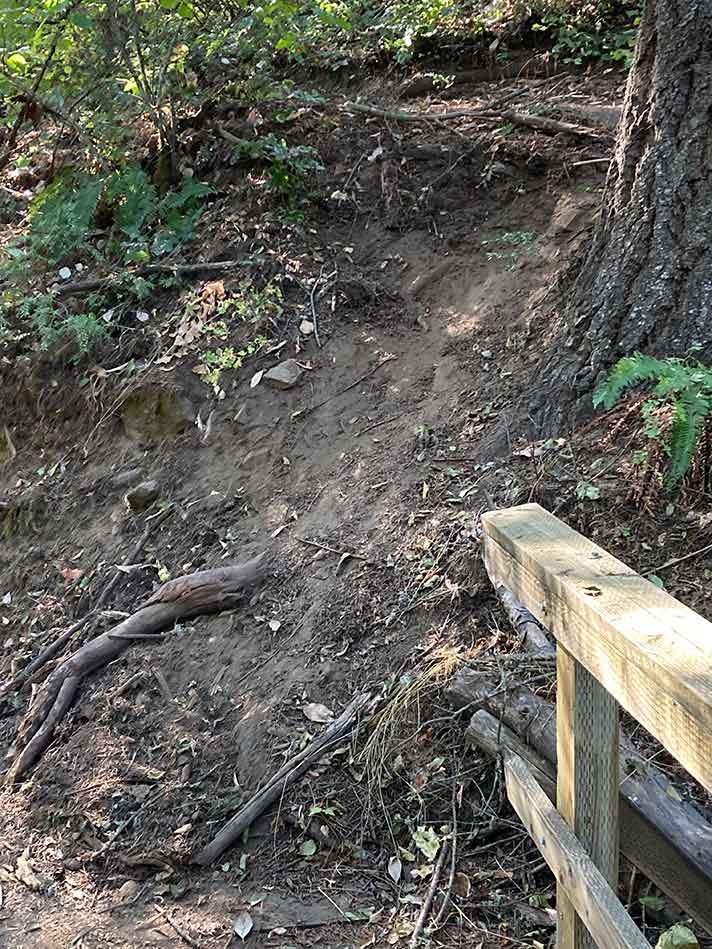Trail Talk – November 2022
For this issue’s musings, I’m putting on my Forest Park Volunteer cap. The last two years have seen a considerable growth in the number of folks enjoying Forest Park. In a recent issue, an explanation was given of the relationship between Jacksonville Woodlands Association and Forest Park, which is managed as a city park. This offering will focus on some of the issues we face as we work to keep Forest Park the rough-cut gem that it is.
Currently, 6 volunteers are trained to IMBA standards for trail-building and maintenance regarding the 40 plus miles of multi-use and hiking trails. The IMBA (International Mountain Bike Association) standards adopted by Jacksonville’s Public Works Department are used throughout the world for hiking and multi-use trails. A separate group of volunteers is responsible for the bike-only single track within the park.
As you hike throughout Forest Park, you will find these fine folks widening and leveling grades and tread, overhauling trails in areas that need additional TLC, cutting back brush and removing noxious weeds and poison oak, and maintaining infrastructure such as benches, bridges, kiosks, and shelters. Most work takes place in winter and spring, when moist soils are more susceptible to being packed, while obviously much easier to dig in. When trees fall across the trail, they are generally removed, except in cases where they can be utilized as deterrents for errant mountain bikers on hiking-only trails.
Because of the steep slopes in Forest Park, which incorporates a large percentage of E. Fork Jackson Creek’s watershed, trails are necessarily narrow to inhibit intrusion on the surrounding environment. Trail engineering has leaned heavily toward preserving as much of the natural landscape as possible. Jacksonville ordinances call for a 10 mile-an-hour speed limit within the park, so these narrow trails are generally suitable for mountain bikes, where allowed. Consideration is given to sight lines, and where steep grades flow into congested areas, turns are incorporated to slow traffic.
One of the more challenging aspects of Forest Park trail work is the different soils found throughout the watershed. Decomposed granite, metamorphosed clays and silts, and rocky intrusions all call for consideration when designing trail grade and tread width. Where trails continually erode from use, additional reinforcement may be used to establish permanence. Muddy trails in winter may occur, but our current climate has been less than favorable to this situation.
Besides the general maintenance of trails this winter, visitors will see some improvements on existing trails. Twin Peaks and Arrowhead Pass Trails (old logging roads) both have steep, often rocky stretches that are uncomfortable to down-hill hikers. A smoother, more gentle tread will be constructed through these areas, while maintaining a climbing grade for mountain bikers. These improvements should give hikers’ knees some relief. And, a bridge, to replace the undersized double-culvert at the north end of Ol’ Miners’ Trail at its intersection with Canyon Falls Trail, will improve passage for hikers, bikers, and aquatic organisms.

 Trail Talk is a monthly column by Clayton Gillette about hiking the Jacksonville Woodlands trail system. For more information, please visit the Jacksonville Woodlands Association website at
Trail Talk is a monthly column by Clayton Gillette about hiking the Jacksonville Woodlands trail system. For more information, please visit the Jacksonville Woodlands Association website at